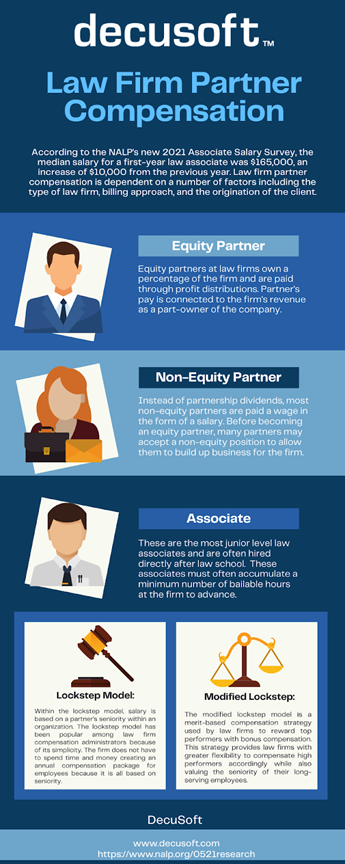According to the NALP’s new 2021 Associate Salary Survey, the median salary for a first-year law associate was $165,000, an increase of $10,000 from the previous year. Law firm partner compensation is dependent on a number of factors including the type of law firm, billing approach, and the origination of the client. Read on to find out more about law firm partner compensation tactics and strategy.
Equity vs Non-Equity Partner
There are two main types of associates at law firms – equity partners and non-equity partners.
Equity Partner: Equity partners at law firms own a percentage of the firm and are paid through profit distributions. Because equity partners have a stake in the business, they encounter greater job security than non-equity partners. If they do not accumulate enough billable hours the firm may move them to non-equity partners status.
Equity partners have a higher level of responsibility and risk, however, as they will be on the line if the firm goes bankrupt. Equity partners enjoy full voting rights on company decisions such as hiring or firing attorneys, recruiting new talent, and other firm resolutions.
Non-Equity Partner: Instead of partnership dividends, most non-equity partners are paid a wage in the form of a salary. Before becoming an equity partner, many partners may accept a non-equity position to allow them to build up business for the firm. Non-equity partners do not experience the same job security as their counterparts because they are not part owners in the firm.
Depending on how the company is structured, staff partners may be paid on a W2 basis.
Non-equity partners do not have full control over the firm’s decisions through voting rights, unlike equity partners. Non-equity partners must usually establish a minimum number of billable hours per year to be considered for an equity partner position.
Equity Law Firm Partner Compensation
Single Tier Partnership
The single-tier partnership model is one of the most long-standing and previously very popular models of equity partnership. In this model young associates would be recruited fresh out of law school and then after years of hard work, blood, sweat, and tears would be asked to join the firm as a partner.
Partners in this model are given an equity stake in the business, hence the phrase “equity partner.” This is in contrast to associates who are only paid in wages and performance bonuses. A partner’s pay is connected to the firm’s revenue as a part-owner of the company.
Equity partners are paid in either a monthly or quarterly “draw” which is a distribution of the firm’s profits over a certain period of time. This draw can be determined by a compensation committee, agreed to by fellow partners, or may be based on the performance of billable hours.
Two-Tier Partnerships
After the 1980s and beyond the two-tier partnership model became very common among law firms. This model became popular as more lateral hiring practices were introduced to the industry, making the associate/partner relationship outdated.
These lateral hires are considered income partners or “non-equity” partners and are paid a salary again determined by the law firm patterns or a compensation committee. These mid-tier attorneys are offered a say in some aspects of the governance of the firm but do not have an equity stake in the firm.
How do attorneys get compensation?
It can also vary depending on an attorney’s reputation. Client-specific attorneys’ compensation is decided in one of four ways, either directly or indirectly: flat fee, hourly, contingency fee, or retainer. Payment plans based on a flat fee: This is a task-based payment system.
Flat fee: This is a predetermined fee agreed upon before any work is completed on the client’s case.
Hourly: A fee billed per hour for a law firm’s services rendered.
Contingency fee basis: Lawyers paid on a contingency fee basis only receive a payment if the case is won.
Retainer: A retainer is a fee that the client pays upfront to an attorney before the attorney has begun work for the client.
Billable Hours: Billable hours are used to calculate the value of a lawyer’s time spent on a case and what the law firm can invoice the client for at the end of the case or billing period.
Billing Partner: The billing partner is responsible for bringing the client’s case to the firm or may perform the majority of work on the client’s case. This partner may also be someone who has historically worked with this client’s matters.
Law firm compensation models
The profit margin of a law partner’s practice is the main determining factor when considering their compensation. There are many elements that influence a law partner’s revenue and expenses beyond the size of the law firm and the amount of overhead allocated including partner billing hours, rates, collection procedures, and any additional partner hours billed. When it comes to profit margins, clients and partners have a wide range of profitability.
Lockstep Model: Within the lockstep model, salary is based on a partner’s seniority within an organization. The lockstep model has been popular among law firm compensation administrators because of its simplicity. The firm does not have to spend time and money creating an annual compensation package for employees because it is all based on seniority.
Modified Lockstep: The modified lockstep model is a merit-based compensation strategy used by law firms to reward top performers with bonus compensation. This strategy provides law firms with greater flexibility to compensate high performers accordingly while also valuing the seniority of their long-serving employees.
Subjective: The subjective compensation model is determined individually for each new hire by the fellow law partners and is kept private from fellow associates.





